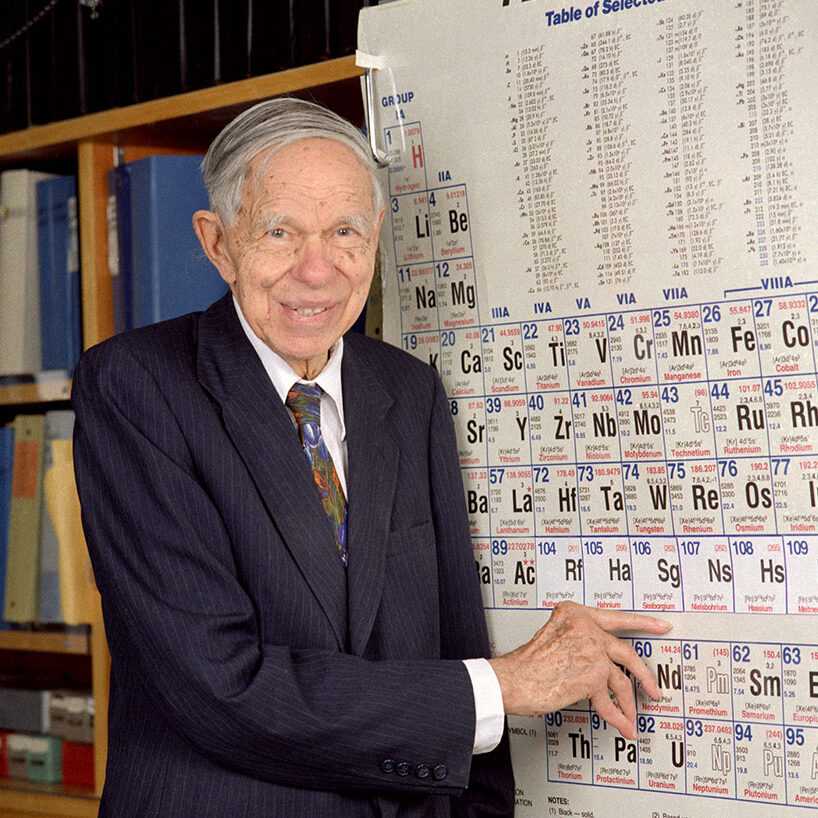Glenn T. Seaborg was born in Ishpeming, Michigan, on April 19, 1912, of Swedish ancestry. His father, Herman Theodore Seaborg, was the son of Swedish immigrants; his mother, the former Selma Olive Erickson had come to the United States from Grängesberg, Sweden. When he was ten, his family moved to Home Gardens, California (now part of South Gate near Los Angeles) where his parents still reside. There after finishing grammar school in 1925 he attended the David Starr Jordan High School in Los Angeles, from which he was graduated in 1929.
He entered the University of California at Los Angeles in September, 1929, earning his way through school by working at various jobs. By 1931 he had been accepted as an assistant in the University’s chemistry laboratory preparing samples and doing some research and teaching. During his last two years, through his courses at the university, nuclear physics and chemistry captured his imagination and he concluded that he would pursue this field. In 1934 Seaborg received his A.B. degree and transferred to the University of California at Berkeley. There in 1937 he earned his Ph.D., his thesis subject being the inelastic scattering of fast neutrons. The following two years he was laboratory assistant to Dr. Gilbert Newton Lewis, then Dean of the College of Chemistry on the Berkeley campus.
In 1939 he received his appointment from the University of California as an Instructor, and in 1941 he was promoted to the rank of Assistant Professor. From 1942 to 1946, he was on leave of absence from the University of California acting as chief of the section working on transuranium elements at the Manhattan Project’s wartime Metallurgical Laboratory at the University of Chicago. Shortly after he joined the Manhattan Project in 1942 he married Helen L. Griggs, then secretary to Nobel Laureate E.0. Lawrence. They now have four children Peter Glenn, Lynne Annette, David Michael, and Stephen Keith.
Dr. Glenn Seaborg with Ion-Exchanger illusion column of actnide elements, May 19, 1950.
While still on leave from the University of California, he was promoted from the rank of Assistant Professor to that of full Professor (1945). In May, 1946, he returned to the University of California to assume his position in the Chemistry Department and to take responsibility for the direction of the nuclear chemical research in the Radiation Laboratory of the University.
Among his major contributions are his discoveries, with several collaborators, of the transuranium elements plutonium (94), americium (95), curium (96), berkelium (97), and californium (98), and the study of their chemical properties and their position in the periodic table.
He is at present engaged in research work at Berkeley on the transuranium elements and on the identification of various nuclear reactions induced as a result of the operation of the Berkeley 184-inch cyclotron. He is also directing the work of a group of graduate students in the field of nuclear chemistry as well as teaching lecture courses in this field.
He has received the following appointments and honors: General Advisory Committee to the U.S. Atomic Energy Commission (1946-1950); second annual Harrison Howe Memorial Lecturer (Rochester, New York Section of the American Chemical Society, 1946); Councillor-at-large of the American Chemical Society (1947); Award in Pure Chemistry (American Chemical Society, 1947); Nieuwland Lecturer at the University of Notre Dame (1947); member of the National Research Council’s Committee on Standards and Units of Radioactivity (since 1947) and of their Subcommittee on Nuclear Constants of the Committee on Nuclear Science (1947- 1951); William H. Nichols Medal (New York Section of the American Chemical Society, 1948); member of the Joint Commission on Radioactivity of the International Council of Scientific Unions (1946-1951); John Ericsson Gold Medal (American Society of Swedish Engineers, 1948); Secretary-Treasurer (1949-50), Chairman-Elect (1950-51), Chairman (1951-52) of the Division of Physical and Inorganic Chemistry of the American Chemical Society; Associate Editor of the Journal of Chemical Physics (1948-50); member of Editorial Board of the Journal of the American Chemical Society (since 1950); Foster Lecturer at the University of Buffalo (1951); co-winner of 1951 Nobel Prize in Chemistry.
He is a member of the following societies: American Chemical Society, American Association for the Advancement of Science, American Institute of Chemists, American Physical Society, National Academy of Sciences, Royal Swedish Academy of Engineering Sciences, Sigma Xi, Phi Beta Kappa, Alpha Chi Sigma, Phi Lambda Upsilon, Royal Society of Arts (England).
His publications include papers on artificial radioactivity and problems in nuclear physics and chemistry, the transuranium elements, high energy nuclear reactions and the compilation of complete tables of isotopes.
[Dr. Seaborg died in 1999]
© the Nobel Foundation 1952
